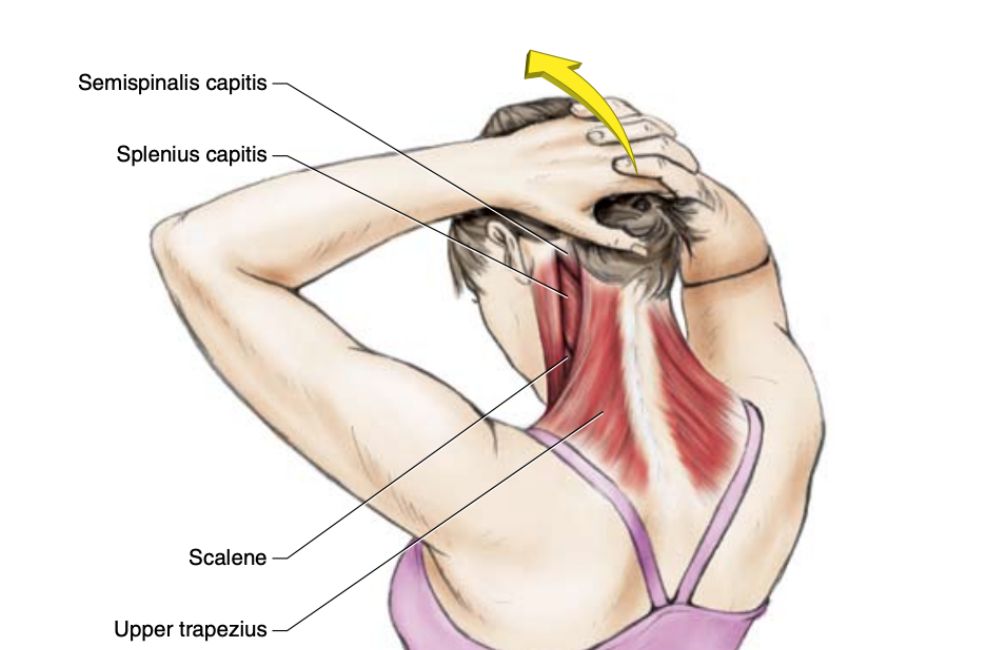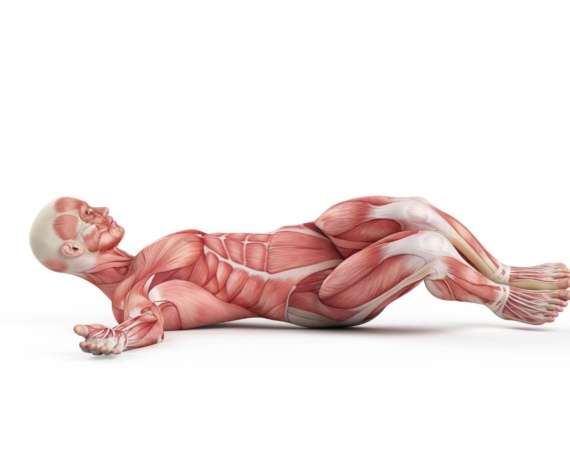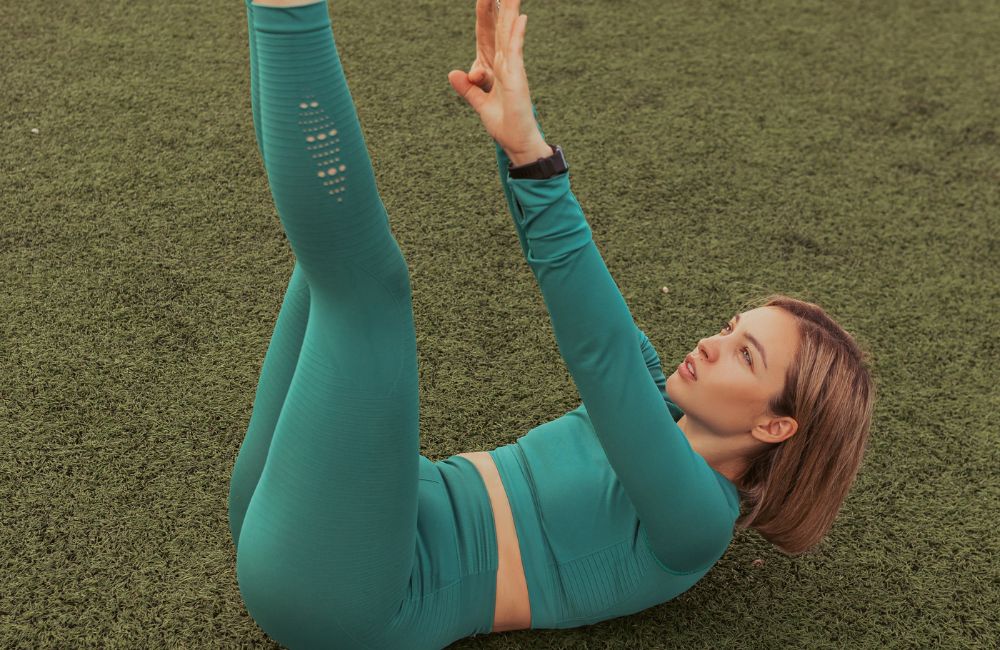
Looking to tone your midsection? Ab exercises are key to sculpting a flat stomach. The journey to a flat abs can be influenced by factors like genetics, diet, and lifestyle choices. These variables can either facilitate or hinder the development of a toned midsection.
Despite these challenges, incorporating effective ab exercises is crucial for achieving the desired results.
In this article, we’ll explore the top 12 abdominal movements proven to help you attain a chiseled midsection.
The Best Ab Exercises to Get a Flat Stomach

To truly get effective ab workouts, you have to incorporate the best ab exercises to target your entire core. Below, I’ll share the best ab exercises to do just that, based on science.
Your Abdominal Anatomy
If you are trying to fix a problem with your car, you need to know where all of the parts are and how they work. The same goes for your body. In order to develop a strong core with defined abs, you must have a basic understanding of abdominal anatomy and physiology.
The “core” can be loosely defined as a group of muscles that helps to stabilize your trunk during movement. Because this is a fairly general definition, you may hear different professionals include certain muscles within the core, while others exclude said muscles.
However, there are 4 muscles that are almost always included within the “core”. The muscles in question are the rectus abdominis, the transversus abdominis, the external obliques, and the internal obliques.
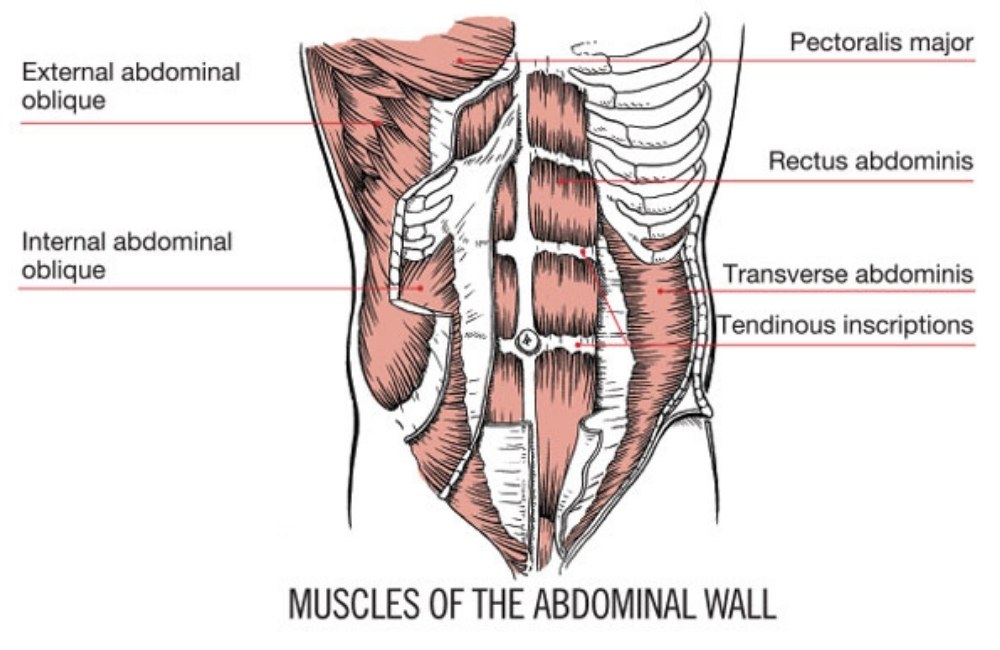
Rectus Abdominis
The rectus abdominis, or RA, is the “six-pack” muscle. This is the muscle most people imagine when they think of defined abdominals. Essentially, the rectus abdominis serves to bend (flex) the trunk, while also stabilizing the spine during movement.
Transversus Abdominis
The transversus abdominis, or TA, is a muscle that can’t be seen by the naked eye. This muscle lies underneath the RA. The TA serves to stabilize the spine, while also helping with visceral stability and function.
External/Internal Obliques
The external and internal obliques serve such similar functions that it is often easier to group them together. These muscles lie on the sides of the trunk and help with side-bending, rotation, and general core stability.
12 Best Abs Exercises for a Flat Tummy
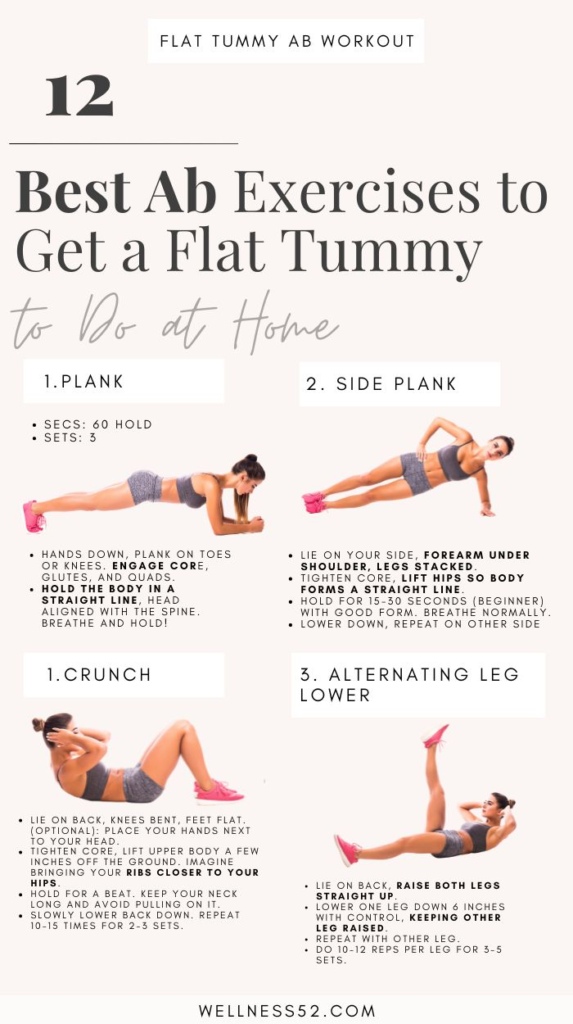
Without further ado, let’s detail the 12 best ab exercises that can help you achieve the 6-pack you’ve always dreamed of!
1. Plank
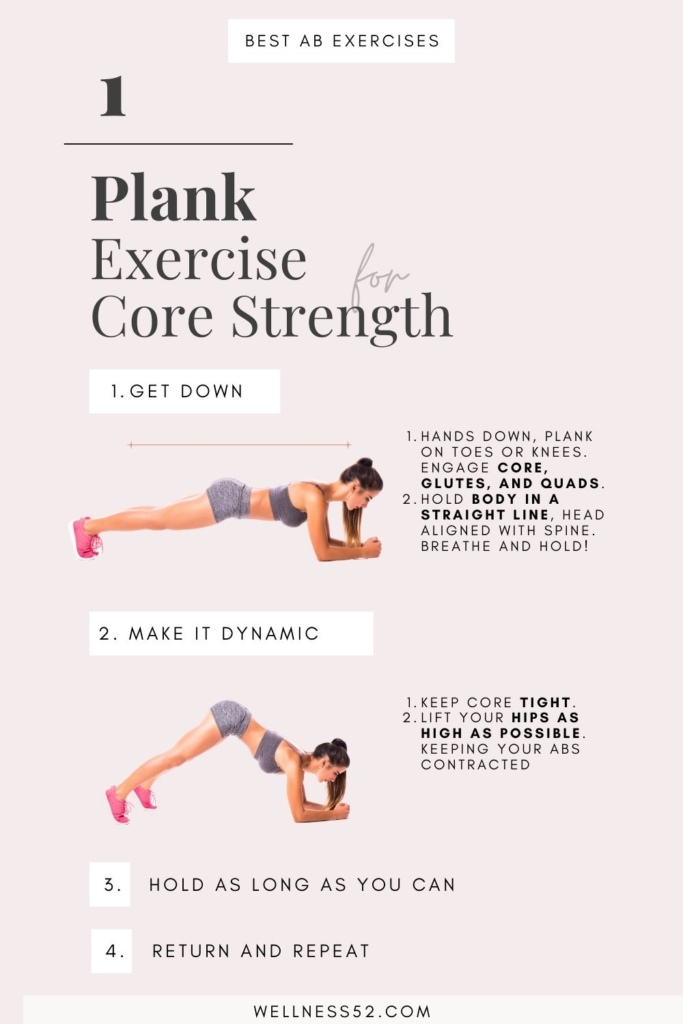
The traditional plank is an exercise that has stood the test of time. This movement has been popular for decades, and for good reason. Planks help to strengthen the abdominals isometrically and can provide a way to gain a significant level of ab strength.
How to Perform:
- Start by lying on your stomach.
- Place your forearms on the ground, with your hands pointed forward.
- Next, tuck your toes underneath you, with your feet roughly hip-width apart.
- Lift your body up so that only your forearms and toes are in contact with the ground.
- Tighten your abdominal muscles and ensure that your back is flat.
- Hold this position for as long as you can without losing form (aim for 30 seconds and 3 sets).
- Generally, losing form with the plank includes allowing the back to sag or “piking” your hips up in the air.
2. Side Plank
Much like the traditional plank, the side plank helps to build stability through isometric exercise. However, the side plank tends to emphasize the obliques more than the rectus abdominis.
How to Perform:
- Start by lying on your right side, with your right forearm planted flat on the floor.
- Stack your left foot on top of your right foot and raise your hips off of the ground.
- At this point, you should essentially have created a straight line from your head down to your feet.
- Hold this position for as long as you can without losing form (aim for 30 seconds and 3 sets per side).
3. Crunch
Along with pushups, squats, and pull-ups, crunches have been a calisthenic staple for years. This move is simple, yet effective for improving core strength.
How to Perform:
- Lie on your back with your knees bent and your feet flat on the floor.
- Cross your arms over your chest so that your left hand is on your right shoulder and vice versa.
- Slowly lift your shoulder blades off of the floor, aiming to “bend” your trunk upward.
- Next, slowly return to the starting position to complete the repetition.
- Complete 12-15 reps for 3-5 sets per session.
4. Alternating Leg Lower
Interestingly, the abdominals tend to be highly active during certain movements involving the legs.
This is due, in part, to the fact that the abs need to stabilize the spine when the extremities are in motion. The alternating leg lower exercise is a great way to work all of the abdominal muscles in one move.
How to Perform:
- Begin by lying on your back.
- Lift both legs off of the ground so that your heels are pointed directly toward the ceiling.
- With control, lower your right leg, keeping the knee straight, until it is roughly 6 inches from the ground.
- While you lower your right leg, ensure that your left leg continues to remain elevated, with your heel pointed to the sky.
- Then, return your right leg to the starting position and repeat the motion with the left leg.
- Continue to alternate between legs until you have completed 10-12 repetitions on each side.
- Perform 3-5 sets per session.
5. Deadbug
The deadbug is a favorite exercise of many physical therapists. The movement can be modified in tons of different ways in order to accommodate individuals of various ability levels.
This makes the dead bug a great choice for nearly all clients with back pain or core instability in general. While there are many variations of this movement, I’ll describe the most common version of the dead bug.
How to Perform:
- Start by lying on your back with your feet flat on the floor and your knees bent.
- Lift both feet off of the ground, keeping your knees bent, until your knees are pointed towards the ceiling.
- Next, bring both arms off of the ground, with your hands pointed toward the ceiling.
- Extend your left leg forward, so that your left heel is roughly 6 inches from the ground.
- At the same time, extend your right arm behind you, while keeping your right leg and left arm in the starting position.
- Return your left leg and right arm to the starting position and repeat on the other side.
- Alternate between sides with this movement until you have completed 10-12 reps on both sides.
- Complete 3-5 sets of this exercise per session.
6. V-Up
The V-Up is an advanced movement that is difficult for even seasoned exercisers to master. However, with consistent practice, you’ll be well on your way to a picture-perfect V-Up in no time.
How to Perform:
- To start, lie on your back with your legs straight and your arms overhead.
- Next, lift your shoulders and as much of your back as you can off of the ground.
- Simultaneously, aim to lift both legs off the ground, keeping your trunk and knees straight.
- At this point, your body should look like a “V”, hence the name of the exercise!
- Perform 10-12 repetitions for 3-5 sets per session.
7. Reverse Crunch
As you may have noticed, many abdominal exercises either involve bending the trunk or lifting the legs to stress the core muscles. The reverse crunch is just as it sounds. It is the opposite of a crunch, but with the same goal of strengthening the abs.
How to Perform:
- Lie flat on your back with your knees bent and your feet flat on the floor.
- For some people, it is more comfortable to pad your backside up during this movement with a pillow or with your hands. This is entirely up to you!
- Lift your feet off of the ground while simultaneously bringing your knees toward your chest and lifting your hips up in the air.
- Slowly return to the starting position to complete the rep.
- Repeat this motion for 10-12 reps for 3-5 sets per session.
8. Bear Crawl
Bear crawls are great for both athletes as well as the average client looking to increase total body strength and coordination. Like many of the movements on this list, bear crawls can be modified in a variety of ways.
In this manner, you can decrease the chances of becoming bored with the movement. Furthermore, varying the bear crawl can also help you to overcome many plateaus that you might reach with bodyweight exercise.
How to Perform:
- Place both hands and feet on the ground, keeping a slight bend in your knees and elbows.
- To complete the movement, simply walk forward for 10-15 feet on all fours by alternating arm and leg movements.
- Aim for 10-12 laps of this distance for 3-5 sets per session.
9. Heel Taps
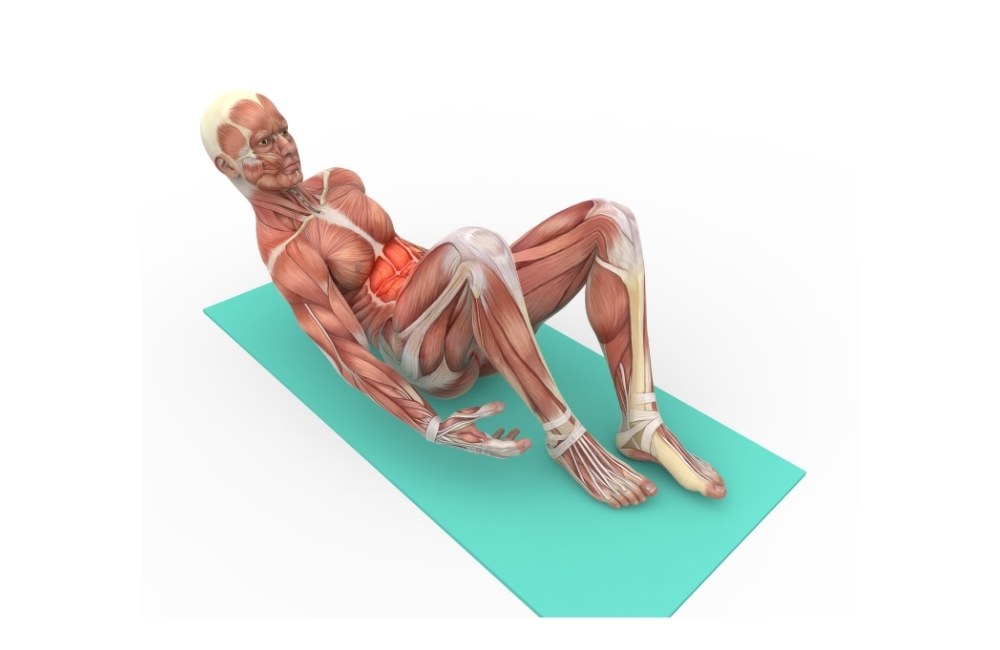
For many people, heel taps are a great introduction to core strengthening exercises. This movement heavily emphasizes the obliques and the rectus abdominis, but it is not a very difficult move to master.
How to Perform:
- Lie on your back with your knees bent and your feet flat on the floor.
- Perform a crunch by lifting your shoulder blades off of the floor slightly.
- Maintaining this crunch position, tap your right heel with your right hand, then alternate by tapping your left heel with your left hand.
- Continue this pattern until you have completed 10-12 reps per side for 3-5 sets per session.
10. Russian Twist
It’s unclear when this move became extremely popular. Many people point to the scene in Rocky IV in which the Russian opponent, played by Dolph Lundgren, is seen performing the movement.
At any rate, the Russian twist is an excellent exercise for strengthening the obliques.
How to Perform:
- Start in a seated position with your feet flat on the floor and your knees bent.
- Lean your trunk backward until you feel your abdominal muscles engage.
- Then, with or without a weight in your hands, twist your trunk from side to side, aiming to tap the ground on every rep.
- Complete 10-12 reps per side for 3-5 sets per session.
11. Wood Chop
For baseball players, tennis players, any individual using rotational movements in their sport, or simply anyone who wants a shredded core: wood chops are a great choice. This movement is functional and extremely effective.
How to Perform:
- Start by standing with your knees slightly bent, linking your hands together, or holding a lightweight (if you wish).
- Bring the weight (or your hands) down toward your right hip to begin the motion.
- Next, rotate upward toward your left shoulder.
- Return to the starting position to complete the rep. Repeat on both sides for 10-15 reps for 3-5 sets per session.
- You should aim to use your hips and core muscles to power this movement as opposed to your arms.
12. Bird Dog
Last, but not least, is the bird dog. This exercise is incredible for building overall core strength. Furthermore, it is one of the best movements around for increasing spinal stability through multifidi activation.
How to Perform:
- Start with your hands flat on the floor, directly underneath your shoulders.
- Additionally, place your knees on the floor, directly underneath your hips.
- Slowly, extend your left arm forward as you extend your right leg backward.
- Next, gradually bring your hand and foot back to the starting position to complete the rep.
- Perform 10-12 reps per side, per set, for 3-5 sets per session.
How Often Should I Train My Abs?
The frequency of ab training is a controversial subject. Some trainers have suggested that, because the abs are used all day, every day, there’s no reason to ever take a day off from training said muscles.
However, other experts suggest that the abs need rest days just like any other muscle group.
In my opinion, it’s always a good idea to incorporate sufficient rest for every muscle group. For this reason, I think it’s a good idea to train abs 2-4 times a week. This is especially true for beginners, whose muscles aren’t used to being stressed to a high degree on a daily basis.
How Many Ab Exercises Should I Do in One Workout?
As frustrating as this answer may be: it depends. There are many schools of thought on this issue.
On the more conservative side, some professionals would recommend performing a few (2-3), key, multi-joint exercises for each muscle group per exercise session.
On the other end of the spectrum, some experts may suggest performing a specific single-joint exercise for each muscle group per exercise session.
Again, I tend to be more conservative with my recommendations in order to avoid overuse injuries. I think that a few targeted exercises, performed with precision and appropriate intensity are sufficient for excellent results.
Conclusion – Best Ab Exercises
Obtaining a defined 6-pack is a hard thing to accomplish. However, if you’re willing to put in the work, you can slowly work towards this goal over many weeks and months. Plus now you have a list of the best ab exercises of all time.
Good luck!

